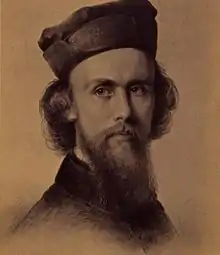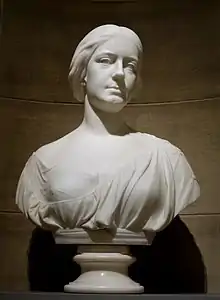Benjamin Paul Akers
Benjamin Paul Akers (July 10, 1825 – May 21, 1861) was an American sculptor from Maine.
Benjamin Paul Akers | |
|---|---|
 Portrait of Paul Akers | |
| Born | July 10, 1825 Westbrook, Maine, U.S. |
| Died | May 21, 1861 (aged 35) Philadelphia, Pennsylvania, U.S. |
| Known for | Sculpture |
| Awards | Commemorative Silver Medal in 1854 |
| Patron(s) | Samuel Appleton and John Neal |
Early life
He was born in 1825 in rural Saccarappa, Maine, into a large and indigent family.[1] When his father, Deacon Akers, moved the family from Saccarappa to Salmon Falls on the Saco River, he started a wood-turning mill. For six years the young Akers worked in his father's mill, where he invented beautiful patterns and "turned" toys. His brother, Charles "Carl" Akers, was also a sculptor and crayon portrait artist. He wrote articles on art for the Atlantic Monthly and also The Crayon, a short-lived New York art magazine in the mid-19th century.[2] Akers spent the winter of 1849 in Boston learning the art of plaster casting with the sculptor Joseph Carew. In 1850 he opened a studio in Portland, Maine. He received a "Commemorative Silver Medal" in the 1854 Exhibition and Fair of the Maine Charitable Mechanic Association. The award was for his bas relief called Peace.[3] In 1855, at age 30, he went to Rome, Italy where he worked for several years.[4]
His experience in Italy and its revelation to his immature art-spirit he discloses in a letter written in 1853:
"I was thrown at once from a world where not in all my life had I seen art, although I lived there with my own shadowy creations—not strong, for I knew not the mighty or the feeble—thrown at once into a world where all was art. All around me, on earth, in the far heavens, were multitudes of forms, all silent but all demanding place; and none might help me, none to say 'here' or 'there'; I only in this mighty realm to appoint, to assign. I was set down in the Louvre a boy from the woods of that new world, no idle spectator."[1]
Career
Patron John Neal claimed Akers was "the first person, man or woman, that ever tried to model anything in the shape of a head" in Portland, Maine.[5] Neal provided Akers a studio space and commissioned his first bust.[6] Among his works are busts of Edward Everett and Henry Wadsworth Longfellow, a head of John Milton and The Dead Pearl Diver,[7] on display at the Portland Museum of Art. Nathaniel Hawthorne described Dead Pearl Diver as an important work of the protagonist, Kenyon, in his novel The Marble Faun, acknowledging his debt to Akers in the introduction. Neal lamented his passing, claiming that "had he lived a few years longer, he would have built up a reputation for himself and his beloved country, well worth coveting.[8]
He planned a free gallery of art for New York, to contain copies in marble of the chief works of ancient art, but in the midst of his work and plans his health failed and he returned home in 1858, and the next year started for Rome, where after his arrival he entered upon the execution of a commission from August Belmont of a statue of Commodore Perry for Central Park, New York, which was left unfinished.[1]
Marriage and children
In 1858 Akers met Elizabeth Taylor Allen a young mother, journalist and poet, and they married in August 1860 in Hollis.[9] Their only child, Gertrude Rothermel, died in infancy. Akers died in Philadelphia, Pennsylvania on May 21, 1861, from tuberculosis.[10] He is buried in Portland's Evergreen Cemetery.[11]
Gallery
 Elizabeth Ann Chase Taylor Akers Allen by Benjamin Paul Akers, c. 1860, in the Portland Museum of Art
Elizabeth Ann Chase Taylor Akers Allen by Benjamin Paul Akers, c. 1860, in the Portland Museum of Art The Dead Pearl Diver by Benjamin Paul Akers. Portland Museum of Art
The Dead Pearl Diver by Benjamin Paul Akers. Portland Museum of Art Samuel Appleton by Benjamin Paul Akers - Longfellow National Historic Site - DSC04802
Samuel Appleton by Benjamin Paul Akers - Longfellow National Historic Site - DSC04802
Collections
Collections:[7]
- Boston Museum of Fine Art, Boston, Massachusetts
- Harvard University Art Museums, Massachusetts
- Portland Museum of Art, Maine
Books about Akers
- Akers, Benjamin Paul by Thomas William Herringshaw
- Akers, Benjamin Paul, article in National Cyclopedia of American Biography, Vol. 6
- Akers, Benjamin Paul, book by George C. Groce
- The Brick House and Its People, book ca. 1930 by Janet Webb Hobbs
- Akers Brothers: brief sketch concerning those American artists, book ca. 1900 by Franklin Staples
References
- Johnson 1906, p. 66.
- "Archives of American Art". Aaa.si.edu. 2017-10-12. Retrieved 2017-10-17.
- Usher, Leila Woodman (1895). "Benjamin Paul Akers". New England Magazine: An Illustrated Monthly. 11: 461–468.
- "Benjamin Paul Akers, ca. 1860". Retrieved 17 October 2017.
- Neal, John (1874). Portland Illustrated. Portland, Maine: W.S. Jones. p. 22. OCLC 26519992.
- Neal 1874, p. 23.
- "Benjamin Paul Akers Online". www.artcyclopedia.com. Retrieved 17 October 2017.
- Neal 1874, p. 24.
- Johnson 1906, p. 67.
- "Benjamin Paul Akers". chestofbooks.com. Retrieved 17 October 2017.
- "Benjamin "Paul" Akers, ca. 1860". Maine Memory Network. Retrieved 10 November 2017.
Attribution
- This article incorporates text from a publication now in the public domain: Johnson, Rossiter, ed. (1906). "Akers, Benjamin Paul". The Biographical Dictionary of America. Vol. 1. Boston: American Biographical Society. pp. 66–67.
External links
- Benjamin Paul Akers letter collection, 1858-1920 from the Smithsonian Archives of American Art
- . Appletons' Cyclopædia of American Biography. 1900.
- Benjamin Paul Akers at Find a Grave